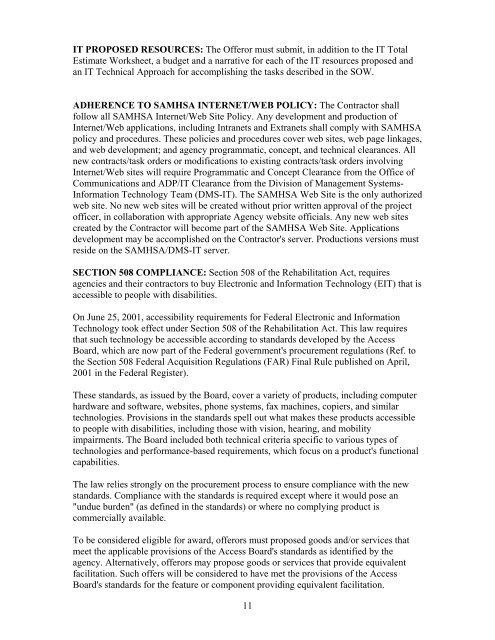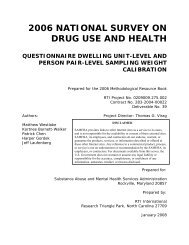1 ATTACHMENT I: STATEMENT OF WORK Section C : Description ...
1 ATTACHMENT I: STATEMENT OF WORK Section C : Description ...
1 ATTACHMENT I: STATEMENT OF WORK Section C : Description ...
Create successful ePaper yourself
Turn your PDF publications into a flip-book with our unique Google optimized e-Paper software.
IT PROPOSED RESOURCES: The Offeror must submit, in addition to the IT Total<br />
Estimate Worksheet, a budget and a narrative for each of the IT resources proposed and<br />
an IT Technical Approach for accomplishing the tasks described in the SOW.<br />
ADHERENCE TO SAMHSA INTERNET/WEB POLICY: The Contractor shall<br />
follow all SAMHSA Internet/Web Site Policy. Any development and production of<br />
Internet/Web applications, including Intranets and Extranets shall comply with SAMHSA<br />
policy and procedures. These policies and procedures cover web sites, web page linkages,<br />
and web development; and agency programmatic, concept, and technical clearances. All<br />
new contracts/task orders or modifications to existing contracts/task orders involving<br />
Internet/Web sites will require Programmatic and Concept Clearance from the Office of<br />
Communications and ADP/IT Clearance from the Division of Management Systems-<br />
Information Technology Team (DMS-IT). The SAMHSA Web Site is the only authorized<br />
web site. No new web sites will be created without prior written approval of the project<br />
officer, in collaboration with appropriate Agency website officials. Any new web sites<br />
created by the Contractor will become part of the SAMHSA Web Site. Applications<br />
development may be accomplished on the Contractor's server. Productions versions must<br />
reside on the SAMHSA/DMS-IT server.<br />
SECTION 508 COMPLIANCE: <strong>Section</strong> 508 of the Rehabilitation Act, requires<br />
agencies and their contractors to buy Electronic and Information Technology (EIT) that is<br />
accessible to people with disabilities.<br />
On June 25, 2001, accessibility requirements for Federal Electronic and Information<br />
Technology took effect under <strong>Section</strong> 508 of the Rehabilitation Act. This law requires<br />
that such technology be accessible according to standards developed by the Access<br />
Board, which are now part of the Federal government's procurement regulations (Ref. to<br />
the <strong>Section</strong> 508 Federal Acquisition Regulations (FAR) Final Rule published on April,<br />
2001 in the Federal Register).<br />
These standards, as issued by the Board, cover a variety of products, including computer<br />
hardware and software, websites, phone systems, fax machines, copiers, and similar<br />
technologies. Provisions in the standards spell out what makes these products accessible<br />
to people with disabilities, including those with vision, hearing, and mobility<br />
impairments. The Board included both technical criteria specific to various types of<br />
technologies and performance-based requirements, which focus on a product's functional<br />
capabilities.<br />
The law relies strongly on the procurement process to ensure compliance with the new<br />
standards. Compliance with the standards is required except where it would pose an<br />
"undue burden" (as defined in the standards) or where no complying product is<br />
commercially available.<br />
To be considered eligible for award, offerors must proposed goods and/or services that<br />
meet the applicable provisions of the Access Board's standards as identified by the<br />
agency. Alternatively, offerors may propose goods or services that provide equivalent<br />
facilitation. Such offers will be considered to have met the provisions of the Access<br />
Board's standards for the feature or component providing equivalent facilitation.<br />
11
















